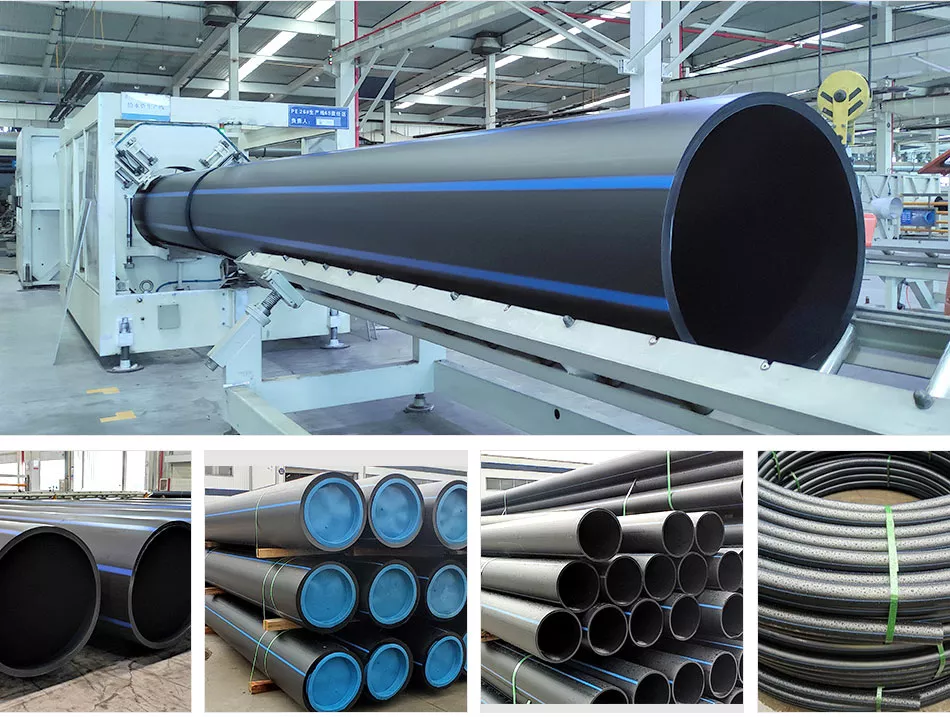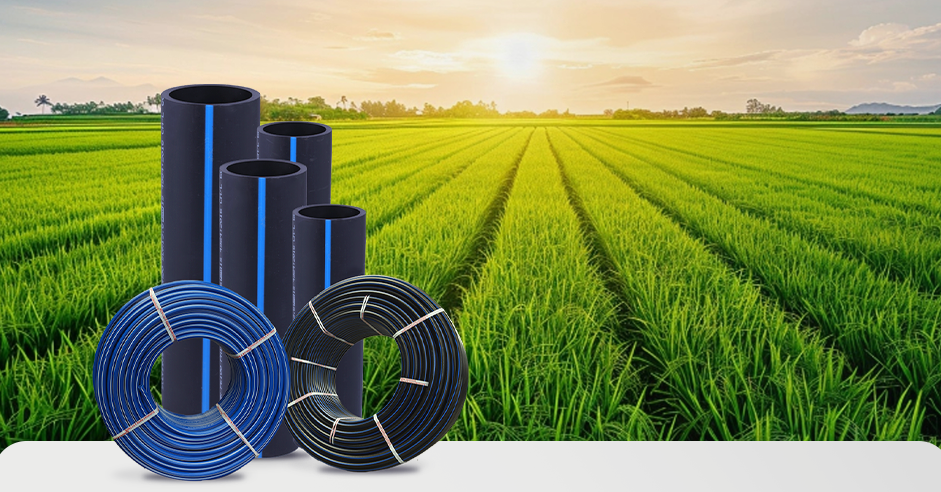Benefits of Choosing custom hdpe pipe manufacturing Midland TX for Specialized Projects
Wiki Article
Check Out the Manufacturing Refine Behind High-Quality HDPE Pipeline and Its Applications
The manufacturing process of premium HDPE pipelines is elaborate and systematic. It begins with the choice of raw materials that boost performance. Following this, ethylene goes through polymerization to develop material, which is then formed through extrusion. Quality control is vital, guaranteeing that the end product fulfills rigid requirements. However, the journey of HDPE pipes doesn't end with manufacturing. Their applications throughout numerous industries reveal a more comprehensive relevance worth analyzing.Recognizing HDPE: Properties and Advantages

High-density polyethylene (HDPE) is a functional polycarbonate understood for its longevity and resistance to different environmental elements. This material shows outstanding tensile stamina, making it suitable for demanding applications. Its low-density structure contributes to a lightweight item, helping with simplicity of taking care of and installation. HDPE also showcases exceptional resistance to chemicals, which decreases degradation when exposed to severe substances.
The product's low moisture absorption further improves its long life, making it perfect for use in pipelines and storage containers. In addition, HDPE is immune to ultraviolet (UV) radiation, making certain that items preserve their honesty also when revealed to sunlight. Additionally, its adaptability permits the production of complex shapes without compromising toughness. The green nature of HDPE, often derived from recycled materials, includes in its appeal, promoting lasting methods in production. On the whole, these buildings and benefits make HDPE a recommended selection for different industrial and customer applications.
Raw Material Option for HDPE Production
The choice of raw materials for HDPE manufacturing is necessary to confirm the last product satisfies the preferred requirements and high quality requirements. High-density polyethylene (HDPE) is largely created from polymerized ethylene, originated from nonrenewable fuel sources such as natural gas or unrefined oil. The quality of these feedstocks significantly influences the mechanical and thermal residential properties of the final HDPE.Additives also play a considerable role in improving HDPE's performance, consisting of antioxidants, UV stabilizers, and colorants, which improve toughness and resistance to ecological variables. The selection process need to consider not only the chemical structure of the raw products however additionally their processing attributes to guarantee efficient production.
The sourcing of raw products should prioritize sustainability and conformity with ecological regulations, as responsible techniques are necessary in today's market. Inevitably, mindful raw product selection lays the foundation for producing high-quality HDPE pipelines ideal for varied applications.
The Extrusion Refine: Shaping HDPE Pipe
The extrusion procedure plays an essential role in shaping HDPE pipes, starting with meticulous product preparation techniques that guarantee ideal circulation and uniformity. Similarly vital is the layout of the die, which directly affects the final measurements and surface area top quality of the pipeline. Together, these aspects contribute significantly to the effectiveness and high quality of HDPE pipe manufacturing.Product Prep Work Methods
Effective manufacturing of HDPE pipes starts with precise product prep work methods, especially the extrusion procedure. During this stage, high-density polyethylene material is very first dried out to get rid of moisture, making sure perfect circulation qualities. The resin is after that fed into the extruder, where it goes through heating and melting, changing right into a thick state. This home heating procedure is very carefully managed to preserve the material's integrity and efficiency. The molten HDPE is required via a die, check out this site shaping it into a continuous pipeline form. Proper temperature level monitoring during extrusion is essential, as it directly affects the product's properties and the end product top quality. When formed, the HDPE pipe is cooled down and reduced to defined lengths, all set for subsequent handling and applications.Die Design Importance
Accuracy in die style plays a vital role in the extrusion procedure of HDPE pipelines. The die acts as the last shaping device, straight influencing the pipe's dimensions, wall surface thickness, and surface coating. A well-designed die assurances uniform product circulation, reducing flaws such as abnormalities and weak spots. The geometry of the die must be enhanced to accommodate the specific residential or commercial properties of HDPE, including its viscosity and thermal habits throughout extrusion. Furthermore, the cooling rate of the product as it goes through the die can markedly impact the pipe's structural honesty. Spending in innovative die innovation is essential for manufacturers aiming to produce high-quality HDPE pipes that satisfy market requirements and client expectations.Quality Assurance Steps in HDPE Production
Although various variables affect the quality of HDPE pipe production, effective quality assurance measures are vital to ensure uniformity and integrity in the last item. Key quality assurance practices consist of strenuous material evaluation, confirming that the raw polyethylene meets established criteria for purity and thickness. During the extrusion process, criteria such as temperature, see this website pressure, and cooling time are very closely checked to preserve dimensional precision and structural honestyFurthermore, post-production testing is vital; producers frequently perform hydrostatic examinations to evaluate the pipeline's strength and resistance to stress. Aesthetic evaluations for surface flaws better enhance high quality assurance. Certification from appropriate standards companies, like ASTM or ISO, supplies an added layer of reputation. By applying these comprehensive quality control actions, manufacturers can lessen defects, enhance performance, and ensure that the HDPE pipelines satisfy the specific demands of numerous applications, inevitably resulting in client contentment and rely on the product.
Applications of HDPE Pipe Throughout Industries
HDPE pipelines are made use of throughout different sectors as a result of their toughness and versatility. In water distribution systems, they ensure reliable delivery, while in wastewater administration, they give trusted solutions for waste transport. In addition, agricultural watering networks take advantage of HDPE's resistance to rust and adaptability, making it a perfect choice for modern-day farming practices.
Water Circulation Equipments
A significant number of sectors rely upon high-density polyethylene (HDPE) pipelines for reliable water distribution systems. Known for their resilience and resistance to rust, HDPE pipes are extensively made use of in community water networks, farming watering, and industrial applications. Their light-weight nature assists in easy handling and installation, reducing labor prices and time. Furthermore, HDPE pipelines can accommodate various pressure degrees, making them ideal for both reduced and high-pressure systems. hdpe pipe fittings Midland TX. The flexibility of the product permits for seamless assimilation right into existing framework, decreasing the demand for extensive excavation. HDPE's resistance to chemical leaching assurances that the water delivered continues to be secure and tidy, making it a perfect selection for keeping the top quality of potable water throughout different fields.Wastewater Administration Solutions
Effective water circulation systems additionally lead the means for cutting-edge wastewater administration options, where high-density polyethylene (HDPE) pipes play a significant role. Popular for their resilience and resistance to corrosion, HDPE pipelines are excellent for delivering wastewater in numerous settings. Their adaptability permits for very easy setup in complicated environments, decreasing the demand for substantial excavation. In addition, HDPE's smooth interior surface area minimizes friction, improving circulation prices and performance. These pipelines are also resistant to chemical leaching, making certain that impurities do not compromise the surrounding atmosphere. Industries, districts, and therapy facilities increasingly rely upon HDPE pipelines for their dependability and long life, making them a favored sewer line protection choice for modern wastewater management systems. This versatility underscores the essential relevance of HDPE pipelines throughout countless applications.Agricultural Irrigation Networks
Agricultural watering networks profit significantly from the use of high-density polyethylene (HDPE) pipes, which offer effective and trustworthy water shipment to plants. HDPE pipes are light-weight, making them easy to carry and install, while their adaptability allows for different arrangements in varied surfaces. These pipelines show outstanding resistance to deterioration, chemicals, and UV radiation, making certain toughness in extreme farming environments. Furthermore, their smooth indoor surface reduces rubbing loss, optimizing water circulation and reducing power expenses connected with pumping. The longevity of HDPE pipes, commonly going beyond 50 years, contributes to reduce maintenance and substitute costs. Subsequently, farmers significantly rely upon HDPE pipes to improve watering performance and advertise sustainable farming practices, ultimately leading to improved plant returns and source preservation.Future Patterns in HDPE Pipe Modern Technology
As the demand for sustainable and efficient framework grows, advancements in HDPE pipeline innovation are positioned to change numerous sectors. Arising patterns include the combination of clever innovations, such as sensors and IoT capabilities, which help with real-time monitoring of pipe conditions, decreasing upkeep expenses and avoiding leakages. In addition, the development of sophisticated manufacturing techniques, such as 3D printing, is making it possible for the production of complicated, personalized pipe designs that deal with certain job requirements.The emphasis on recycling and round economy methods is driving the advancement of HDPE pipelines made from recycled products, boosting sustainability. Boosted jointing methods, such as electro-fusion and mechanical installations, are additionally improving setup performance and integrity. The growing focus on environmental laws is pushing producers to adopt greener manufacturing procedures, guaranteeing that HDPE pipes not just satisfy market standards however also cultivate an even more lasting future for infrastructure growth.
Often Asked Inquiries
Just How Does HDPE Contrast to Other Plastic Materials?
HDPE outshines many various other plastic products regarding resilience, chemical resistance, and adaptability. Its low density and high tensile strength make it ideal for numerous applications, frequently exceeding alternatives in both efficiency and longevity.What Are the Environmental Impacts of HDPE Manufacturing?
The ecological impacts of HDPE production consist of greenhouse gas exhausts, energy consumption, and prospective air pollution from making procedures. In addition, inappropriate disposal can cause dirt and water contamination, elevating issues regarding long-term ecological results.Can HDPE Piping Be Reused?
Yes, HDPE pipes can be reused. Several centers accept utilized HDPE for handling, transforming it into new items. This recycling adds to sustainability initiatives, lowering plastic waste while conserving sources and power in the manufacturing cycle.What Is the Life Expectancy of HDPE Pipeline?

Just How Do Temperature Variants Affect HDPE Pipe Performance?
Temperature variants greatly influence HDPE pipe efficiency, affecting versatility and stamina. Heats can bring about softening, while low temperature levels might trigger brittleness, eventually influencing the pipe's longevity and viability for various applications in varied environments.Report this wiki page